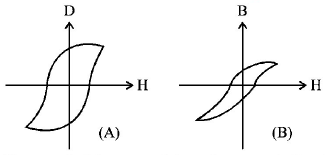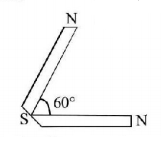1.
Hysteresis loops for two magnetic materials $$A$$ and $$B$$ are given below :

These materials are used to make magnets for electric generators, transformer core and electromagnet core. Then it is proper to use :
A
$$A$$ for transformers and $$B$$ for electric generators.
B
$$B$$ for electromagnets and transformers.
C
$$A$$ for electric generators and transformers.
D
$$A$$ for electromagnets and $$B$$ for electric generators.
Answer :
$$B$$ for electromagnets and transformers.
2. If the angular momentum of an electron is $$\vec J$$ then the magnitude of the magnetic moment will be
A
$$\frac{{eJ}}{m}$$
B
$$\frac{{eJ}}{2m}$$
C
$$eJ\,2m$$
D
$$\frac{{2m}}{{eJ}}$$
Answer :
$$\frac{{eJ}}{2m}$$
3. A bar magnet has coercivity $$4 \times {10^3}A{m^{ - 1}}.$$ It is desired to demagnetise it by inserting it inside a solenoid $$12\,cm$$ long and having $$60$$ turns. The current that should be sent through the solenoid is
A
$$2\,A$$
B
$$4\,A$$
C
$$6\,A$$
D
$$8\,A$$
Answer :
$$8\,A$$
4. A permanent magnet in the shape of a thin cylinder of length $$10\,cm$$ has magnetisation $$\left( M \right) = {10^6}\,A\,{m^{ - 1}}.$$ Its magnetization current $${I_M}$$ is
A
$${10^5}A$$
B
$${10^6}A$$
C
$${10^7}A$$
D
$${10^8}A$$
Answer :
$${10^5}A$$
5. A magnet makes $$40$$ oscillations per minute at a place having magnetic field intensity of $$0.1 \times {10^{ - 5}}T.$$ At another place, it takes $$2.5\,\sec$$ to complete one vibration. The value of earth’s horizontal field at that place is
A
$$0.25 \times {10^{ - 6}}T$$
B
$$0.36 \times {10^{ - 6}}T$$
C
$$0.66 \times {10^{ - 8}}T$$
D
$$1.2 \times {10^{ - 6}}T$$
Answer :
$$0.36 \times {10^{ - 6}}T$$
6. Nickel shows ferromagnetic property at room temperature. If the temperature is increased beyond Curie temperature, then it will show
A
para-magnetism
B
anti-ferromagnetism
C
no magnetic property
D
diamagnetism
Answer :
para-magnetism
7.
The net magnetic moment of two identical magnets each of magnetic moment $${M_0},$$ inclined at $${60^ \circ }$$ with each other is

A
$${M_0}$$
B
$$\sqrt 2 {M_0}$$
C
$$\sqrt 3 {M_0}$$
D
$$2{M_0}$$
Answer :
$$\sqrt 3 {M_0}$$
8. Two identical short bar magnets, each having magnetic moment of $$10\,A{m^2},$$ are arranged such that their axial lines are perpendicular to each other and their centres be along the same straight line in a horizontal plane, If the distance between their centres is $$0.2\,m,$$ the resultant magnetic induction at a point midway between them is $$\left( {{\mu _0} = 4\pi \times {{10}^{ - 7}}H{m^{ - 1}}} \right)$$
A
$$\sqrt 2 \times {10^{ - 7}}\,tesla$$
B
$$\sqrt 5 \times {10^{ - 7}}\,tesla$$
C
$$\sqrt 2 \times {10^{ - 3}}\,tesla$$
D
$$\sqrt 5 \times {10^{ - 3}}\,tesla$$
Answer :
$$\sqrt 5 \times {10^{ - 3}}\,tesla$$
9. Due to the earth’s magnetic field, charged cosmic ray particles
A
can never reach the poles
B
can never reach the equator
C
require less kinetic energy to reach the equator than the poles
D
require greater kinetic energy to reach the equator than the poles
Answer :
require greater kinetic energy to reach the equator than the poles
10. A magnet of magnetic moment $$50\hat i\,A - {m^2}$$ is placed along the $$x$$-axis in a magnetic field $$\vec B = \left( {0.5\hat i + 3.0\hat j} \right)T.$$ The torque acting on the magnet is
A
$$175\,\hat k\,N{\text{ - }}m$$
B
$$150\,\hat k\,N{\text{ - }}m$$
C
$$75\,\hat k\,N{\text{ - }}m$$
D
$$25\sqrt {37} \,\hat k\,N{\text{ - }}m$$
Answer :
$$150\,\hat k\,N{\text{ - }}m$$
